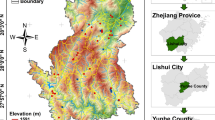Abstract
A susceptibility map for an area, which is representative in terms of both geologic setting and slope instability phenomena of large sectors of the Sicilian Apennines, was produced using slope units and a multiparametric univariate model. The study area, extending for approximately 90 km2, was partitioned into 774 slope units, whose expected landslide occurrence was estimated by averaging seven susceptibility values, determined for the selected controlling factors: lithology, mean slope gradient, stream power index at the foot, mean topographic wetness index and profile curvature, slope unit length, and altitude range. Each of the recognized 490 landslides was represented by its centroid point. On the basis of conditional analysis, the susceptibility function here adopted is the density of landslides, computed for each class. Univariate susceptibility models were prepared for each of the controlling factors, and their predictive performance was estimated by prediction rate curves and effectiveness ratio applied to the susceptibility classes. This procedure allowed us to discriminate between effective and non-effective factors, so that only the former was subsequently combined in a multiparametric model, which was used to produce the final susceptibility map. The validation of this map latter enabled us to verify the reliability and predictive performance of the model. Slope unit altitude range and length, lithology and, subordinately, stream power index at the foot of the slope unit demonstrated to be the main controlling factors of landslides, while mean slope gradient, profile curvature, and topographic wetness index gave unsatisfactory results.






Similar content being viewed by others
References
Abate B, Pescatore T, Renda P, Tramutoli M (1988) Schema geologico dei Monti di Termini Imerese e delle Madonie occidentali (Sicilia). Mem Soc Geol Ital 41:465–474
Agnesi V, Macaluso T, Monteleone S, Pipitone G (1982) Indagine geomorfologica ed analisi statistica dei dissesti dell’ Alto Bacino del Fiume San Leonardo (Sicilia occidentale). Geologia Applicata ed Idrogeologia 27:243–271
Carrara A, Cardinali M, Detti R, Guzzetti F, Pasqui V, Reichenbach P (1991) GIS techniques and statistical models in evaluating landslide hazard. Earth Surf Process Landf 16:427–445
Carrara A, Cardinali M, Guzzetti F (1995) GIS technology in mapping landslide hazard. In: Carrara A, Guzzetti F (eds) Geographical information systems in assessing natural hazards. Kluwer Academic Publisher, Dordrecht, pp 135–175
Carrara A, Crosta GB, Frattini P (2008) Comparing models of debris-flow susceptibility in the alpine environment. Geomorphology 94:353–378
Chung CF, Fabbri A (1995) Multivariate regression analysis for landslide hazard zonation. In: Carrara A, Guzzetti F (eds) Geographical information systems in assessing natural hazards. Kluwer Academic Publisher, Dordrecht, pp 135–175
Chung CF, Fabbri A (2003) Validation of spatial prediction models for landslide hazard mapping. Nat Hazards 30:107–142
Clerici A, Perego S, Tellini C, Vescovi P (2002) A procedure for landslide susceptibility zonation by the conditional analysis method. Geomorphology 48:349–364
Conoscenti C, Di Maggio C, Rotigliano E (2008) GIS analysis to assess landslide susceptibility in a fluvial basin of NW Sicily (Italy). Geomorphology 94:325–339
Cruden DM, Varnes DJ (1996) Landslide types and processes. In: Turner A, Schuster L (eds) Landslides: investigation and mitigation, TRB special report, vol 247. National Academy Press, Washington, pp 36–75
Davis JC (1973) Statistics and data analysis in geology. Wiley, New York
Del Monte M, Fredi P, Lupia Palmieri E, Marini R (2002) Contribution of quantitative geomorphic analysis to the evaluation of geomorphologic hazards: case study in Italy. In: Allyson RJ (ed) Applied geomorphology: theory and practice. John Wiley & Sons, Chichester, pp 335–358
Fabbri A, Chung CF (2008) On blind tests and spatial prediction models. Nat Resour Res 17:107–118
Guzzetti F, Carrara A, Cardinali M, Reichenbach P (1999) Landslide hazard evaluation: a review of current techniques and their application in a multi-scale study, Central Italy. Geomorphology 31:181–216
Guzzetti F, Reichenbach P, Ardizzone F, Cardinali M, Galli M (2006) Estimating the quality of landslide susceptibility models. Geomorphology 81:166–184
Hansen A (1984) Landslide hazard analysis. In: Brunsden D, Prior DB (eds) Slope instability. Wiley, New York, pp 523–602
Remondo J, Gonzalez A, Diaz de Teran JR, Cendrero A, Fabbri A, Chung CJ (2003) Validation of landslide susceptibility maps; examples and applications from a case study in northern Spain. Nat Hazards 30:437–449
Van Den Eckhaut M, Reichenbach P, Guzzetti F, Rossi M, Poesen J (2009) Combined landslide inventory and susceptibility assessment based on different mapping units: an example from the Flemish Ardennes, Belgium. Nat Hazards Earth Syst Sci 9:507–521
Acknowledgments
The research, whose results are here shown and discussed, was carried out in the framework of the Ministry of University funded project (PRIN2007) “EROMED”, national coordinator Prof. G. Rodolfi, local responsible Prof. V. Agnesi. C. Cappadonia, C. Conoscenti, D. Costanzo, and E. Rotigliano have commonly shared all the parts of the research. V. Agnesi has participated to the final interpretation of the data. The authors wish to thank three anonymous reviewers for having given great insight and a number of suggestions useful in improving the quality and readability of this paper. Clare Hampton has linguistically edited the final version of this text.
Author information
Authors and Affiliations
Corresponding author
Rights and permissions
About this article
Cite this article
Rotigliano, E., Cappadonia, C., Conoscenti, C. et al. Slope units-based flow susceptibility model: using validation tests to select controlling factors. Nat Hazards 61, 143–153 (2012). https://doi.org/10.1007/s11069-011-9846-0
Received:
Accepted:
Published:
Issue Date:
DOI: https://doi.org/10.1007/s11069-011-9846-0




